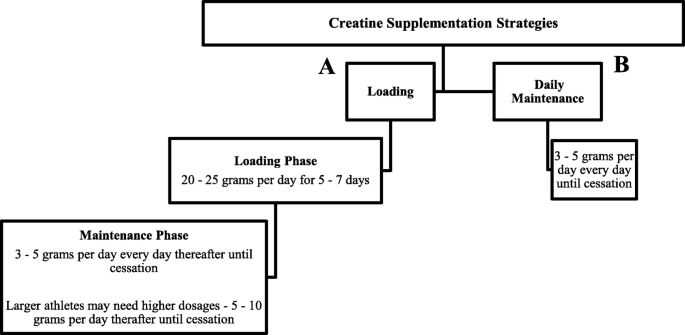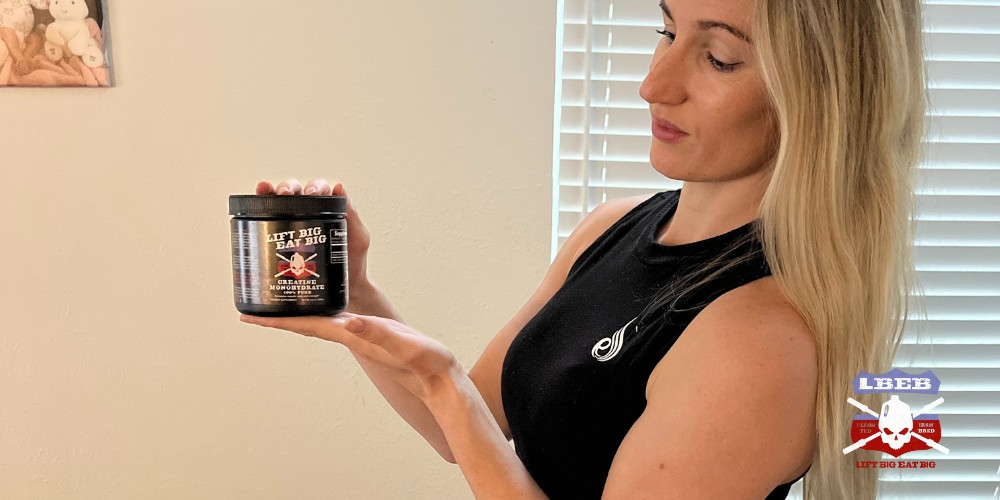A common misconception about creatine is that it’s compulsory to begin with a ‘loading’ phase, where you take about 20g per day for 5 – 7 days to increase the creatine concentration in your muscles. However, is a creatine load necessary for experiencing the health and performance advantages of creatine supplementation? And you may also be asking: “How should I be doing a creatine load?”
While a creatine load is beneficial to speed up the process of building your muscle creatine stores, it is not necessary to reap the benefits of creatine for health and performance in the long term.
If you choose to do a creatine load, it is important to know how to do it and for how long to get the best results and prevent side effects.
Table of Contents
How To Creatine Load
Creatine ‘loading’ involves taking oral creatine for 5-7 days with a dosage of 20-25 grams daily, usually divided into smaller daily doses (e.g., four to five servings of 5 grams each day) [1, 2, 3, 4].
It can also be based on body weight, like 0.3 grams per kilogram per day for 5-7 days (21 grams per day for a 70-kilogram person) [1].
The timing of creatine is less important than the absolute dose so you can take creatine before or after a workout.
However, adding your creatine supplementation to something you already do as a habit, also known as “habit stacking,” a concept coined and popularized by James Clear, the author of Atomic Habits [5].
After the ‘loading’ phase, there’s a ‘maintenance’ phase where people typically take 3–5 gram servings of creatine daily [1].

Figure 1: Creatine supplementation strategies [1]
Is Creatine Loading Necessary?
Many people mistakenly believe that they need to engage in creatine ‘loading’ to boost the amount of creatine stored in their muscles and, consequently, enjoy the claimed performance benefits of creatine supplementation.
Nevertheless, scientific studies have firmly established that lower daily creatine supplementation doses (typically 3-5 grams per day) effectively increase muscle creatine stores.
This leads to more significant muscle mass, performance, and recovery enhancements than a placebo [2].
This means that creatine loading is optional to reap the benefits of creatine supplementation. Nonetheless, a creatine loading phase can expedite the timeframe in which you begin to reap these benefits [1, 3].
Creatine Loading vs. Not Loading
While the chronic, low-dose approach is effective, it does require more time to achieve peak intramuscular creatine stores.
In a study comparing the “loading” and “maintenance” dose strategies, two groups were assigned different dosing regimens [6].
One group took 3 grams of creatine daily for 28 days, while the other took 20 grams daily for 6 days.
Both groups experienced a similar increase in creatine accumulation in the muscles (around 20%), but the group taking 20 grams per day achieved this increase in a comparatively shorter period [6].
As a result, taking the lower chronic dose of 3 – 5g per day for a minimum of 4 weeks is recommended to saturate muscle creatine levels [1].
The strategy chosen to improve muscle creatine stores will depend on your own goals or needs. If you have a short timeframe in which you want to improve performance, it may be better to perform a creatine “load” and then transition to the maintenance dose after 5 – 7 days.
Should You Workout During Creatine Loading Phase?

Yes, you should work out during the creatine loading phase to optimize the benefits of taking creatine.
When you take creatine and add the stimulus of exercise, you can build more muscle, improve exercise intensity and duration, and enhance recovery from exercise [1, 3].
You will also see short-term adaptations and benefits to training when taking creatine, even in the early loading phase [7].
However, it is important to keep on taking creatine, even on rest days. This is because creatine must be taken daily to saturate muscle creatine stores [1, 3].
Should You Load Creatine For 5 Or 7 Days?
Dosages for creatine loading in research studies range between 5 – 7 days [1, 2, 3, 4, 6]. There is no conclusive evidence or comparison studies on which one is better. However, if you have a shorter time frame to improve muscle creatine concentrations, you can consider doing a full week load.
Can You Overdose On Creatine?
The International Society of Sports Nutrition has established that the use of creatine as a supplement is safe and effective when used within the established dosage guidelines, i.e., a loading protocol of about 20 grams for 5 – 7 days and then a maintenance protocol of 3 – 5 grams per day [1, 3].
Safety, efficacy, and side effects have not been established or researched outside of these boundaries, and it is not advisable to take more than necessary.
One study has shown that if you are performing a loading phase of 20 grams per day, distribute this in smaller doses throughout the day because taking more than 10g at a time can potentially cause gut issues [8].
Summary
The main takeaway from this article is while it is not necessary to do a creatine load to benefit from its performance and health enhancing effects, it can decrease the time it takes to saturate muscle creatine stores.
It is important to know how to do a proper creatine load if you choose to go that route and not exceed the recommended dosages to prevent possible side effects.
References
- Antonio, J., Candow, D. G., Forbes, S. C., Gualano, B., Jagim, A. R., Kreider, R. B., Rawson, E. S., Smith-Ryan, A. E., VanDusseldorp, T. A., Willoughby, D. S., & Ziegenfuss, T. N. (2021). Common questions and misconceptions about creatine supplementation: What does the scientific evidence really show? Journal of the International Society of Sports Nutrition, 18(1), 13. https://doi.org/10.1186/s12970-021-00412-w
- Buford, T. W., Kreider, R. B., Stout, J. R., Greenwood, M., Campbell, B., Spano, M., Ziegenfuss, T., Lopez, H., Landis, J., & Antonio, J. (2007). International Society of Sports Nutrition position stand: Creatine supplementation and exercise. Journal of the International Society of Sports Nutrition, 4, 6. https://doi.org/10.1186/1550-2783-4-6
- Kreider RB, Leutholtz BC, Greenwood M. (2004). Creatine. In: Wolinsky I, Driskel J, editors. Nutritional Ergogenic Aids. CRC Press LLC: Boca Raton, FL; 2004. pp. 81–104.
- Williams MH, Kreider R, Branch JD. (1999). Creatine: The power supplement. Champaign, IL: Human Kinetics Publishers; 1999. p. 252.
- Clear, J. (2018). Atomic habits: An easy & proven way to build good habits & break bad ones. Penguin: Avery.
- Hultman, E., Soderlund, K., Timmons, J. A., Cederblad, G., & Greenhaff, P. L. (1996). Muscle creatine loading in men. Journal of Applied Physiology, 81, 232-237.
- Volek JS, Kraemer WJ, Bush JA, Boetes M, Incledon T, Clark KL, Lynch JM. (1997). Creatine supplementation enhances muscular performance during high-intensity resistance exercise. Journal of the American Dietetic Association, 97, 765–770. doi: 10.1016/S0002-8223(97)00189-2.
- Ostojic SM, Ahmetovic Z. (2008). Gastrointestinal distress after creatine supplementation in athletes: Are side effects dose dependent? Research in Sports Medicine, 16, 15–22. doi: 10.1080/15438620701693280.
